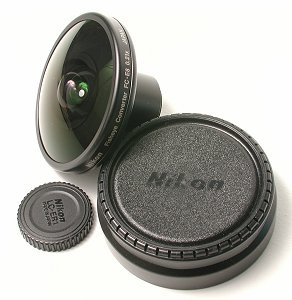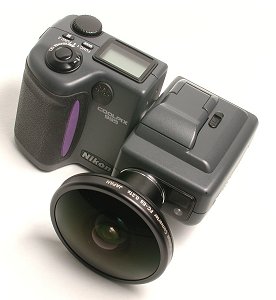
The Nikon Fisheye Converter FC-E8 consists of the lens and front and rear caps. See the image below.

There are some important notes:

This lens has a magnification of x0.21. When it is mounted, it covers 8mm to 32mm (35mm equivalent).
You can use the Fisheye 1 mode for circular fisheye. Or, you can use the Fisheye 2 mode for full-frame fisheye. Note that these modes are only available in M-REC.
Setting the camera to Fisheye 1 causes the on-camera lens to zoom all the way out so that the image is circular. Setting the camera to Fisheye 2 causes the on-camera lens to zoom to a middle position so that you can take full-frame images with fisheye effect. Please note the following important facts:
You do not have to enter a converter mode to use a lens converter even if you are in M-REC. This means you can use this fisheye converter in the Regular mode. See General Operations for the details. In fact, I am more in favor of shooting in the Regular mode because I can use the zooming buttons for composition and select a desired metering method.
While you might not want to use this fisheye converter for close-up work because of its linear distortion, placing this fisheye converter very close to your subject would get you some very creative and interesting effect because the foreground will be greatly exaggerated.
The shortest camera-subject distance is about 5cm/1.95 in, if the converter is set to fullframe fisheye (i.e., Fisheye 2) and the camera is set to the Close-Up mode. In the Regular mode, you can simply zoom in and select the close-up mode to do macro photography.
Whatever mode you are in, keep in mind that you should use the LCD monitor for focusing, and perhaps use exposure compensation for adjusting exposure. Click here to learn more about the use of exposure compensation.
When the on-camera lens is zoomed all the way out to the 38mm position, the fisheye converter creates a combined focal length of 8mm covering 183 degree. The image, however, is a circular one, and does not cover the entire image frame. The following three images demonstrate this "circular" effect.
|
|
|
|
| (a) | (b) | (c) |
| Click on the image to see a larger one | ||
Images (a) and (b) show the distortion (or exaggeration, if you prefer) of straight lines. The grid on the floor in (a) illustrates this effect very well. Lines that are parallel and close to the viewing direction look straight and converging. Lines closer to the edges become more curvilinear. Due to this effect, lines become curves and circles are no more circles (see (b), for example). Because this converter covers more than 180 degree, foreground is dramatically exaggerated and background looks like at infinity. Image (b) was taken under the dome of the Texas capital building in Austin. Image (c) illustrates this 183 degree coverage perfectly. I was standing right below the dome and pointed my camera up. Because the coverage is 183 degree, the image covers every corner above the ground! You can see the doors, hallways, all paintings on the wall, and, of course, the top of the dome.
Since this fisheye converter covers more than 180 degree, it is easy to get your face, your feet and your tripod legs into the image. Therefore, move the camera away from your body and check the LCD monitor to determine if unwanted stuffs are in the image. The following is a good example. When I was taking a picture of my cat by lowering the camera close to the ground, the 180 degree coverage includes part of my face, a stupid and careless mistake!
|
|
| Click on the image to see a larger one |
When you zoom in, the image circle becomes larger and eventually covers the entire image frame. Hence, we have a full-frame fisheye image. The corresponding focal length of this full-frame fisheye is about 15mm (35mm equivalent). Here, full-frame fisheye means the lens has 180 degree coverage along the diagonal. Since there is no ultra-wide lens for Coolpix 995, there is no harm to use a fisheye converter in a situation where even the wide angle converter cannot make a nice shot (e.g., in a small room). The following two images are good examples. Non-linear distortion can be seen; but, it is not as dramatic as in the above images. Or, if you don't mind, you can take a shoulder shot of yourself!
|
|
|
| Click on the image to see a larger one | |
Theoretically speaking, only straight lines passing through the center of the scene can appear as straight lines in the image. Therefore, you should keep this fact in mind when taking landscape images. In the following, image (a) was taken with the wide-angle converter, the horizon is a straight line; image (b) was taken with the fisheye converter by aligning the horizon in the middle of the image, and, as a result, it is straight; and image (c) shows the problem of the horizon being non-rectilinear because the camera is tilted upward.
|
|
|
|
| (a) Wide angle | (b) Circular fisheye | (c) Full frame fisheye |
| Click on the image to see a larger one | ||
![]()
The following technical information are taken from Nikon's manual. These information are for 950/990/995 only, and should be different for other Nikon cameras.
| Item | Technical Data |
| Number of lenses | 5 elements in 4 groups |
| Magnification | x0.21 |
| Combined focal length | 8mm (35mm equivalent) |
| Combined max. aperture | F2.6 at wide angle side |
| Angle of view | 183 at wide angle side |